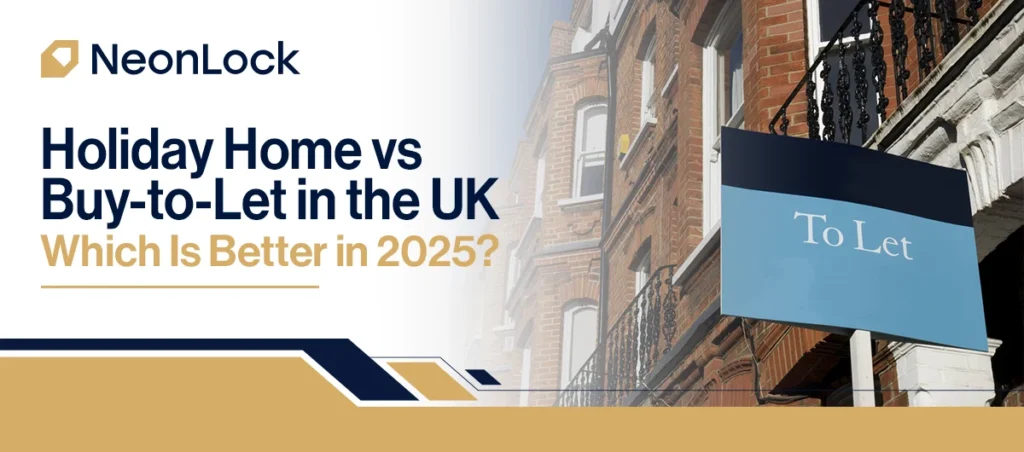Whether you are preparing to make your first property investment or exploring how best to generate income from a property you already own, the key decision lies in choosing the right rental strategy. Should you opt for the short-term flexibility of a holiday home or the steady, long-term security of a buy-to-let?
Traditionally, many UK investors have favoured buy-to-let properties, renting them out to tenants to secure consistent monthly income. However, in recent years, the rise of platforms such as Airbnb has made holiday lets increasingly attractive, offering the potential for higher returns through short-term stays.
The debate of Holiday Home vs Buy-to-Let is particularly relevant in 2025, as shifting market conditions, evolving tax rules, and changing lifestyle trends continue to influence property investment decisions.
In this article, we’ll examine the benefits and drawbacks of both strategies, giving you the insights needed to determine which path best suits your financial goals.
What is a Holiday Home?
A holiday home is a property rented out on a short-term basis, typically to tourists, travellers, or families looking for a temporary place to stay. These lets are often advertised on platforms such as Airbnb or Booking.com and are usually located in popular holiday destinations, coastal towns, or cities with high visitor demand. Investors in holiday homes can benefit from higher nightly rates compared to traditional rentals, but income may fluctuate depending on the season, tourism trends, and local regulations.
What is a Buy-to-Let?
A buy-to-let property is purchased to rent it to tenants on a long-term basis. This type of investment is a well-established route in the UK, providing landlords with consistent monthly rental income. Buy-to-let properties can range from city flats to suburban family homes, and they are generally seen as a stable and reliable option for investors seeking long-term financial security. However, returns may be more modest compared to holiday lets, and landlords must also navigate changing tax rules and regulatory requirements.
At NeonLock, we specialise in helping investors find the best buy-to-let properties across the UK. Our team provides expert advice, local insights, and comprehensive support to help you make informed, profitable decisions.

The Pros and Cons of Buy-to-Lets
Pros
- Greater Access to Mortgages: Buy-to-let properties are regarded by lenders as relatively stable investments, which generally makes securing a mortgage simpler than for holiday lets.
- Stable Rental Income: Tenants typically commit to agreements of twelve months or longer, providing landlords with a predictable and consistent income stream.
- Reduced Upkeep: Day-to-day cleaning and minor maintenance are undertaken by the tenant, leaving the landlord responsible only for routine inspections and essential property maintenance.
- Tenant Reliability: Comprehensive screening procedures help landlords select dependable tenants who are more likely to maintain the property and remain for longer periods.
- Lower Marketing Costs: With tenants usually staying for extended durations, the need for frequent advertising and tenant replacement is significantly reduced.
- More Affordable Management Fees: Property management fees are usually lower for buy-to-lets than for holiday homes, as long-term rentals require less frequent cleaning, advertising, and guest management.
Cons
- Restricted Property Access: Landlords are legally required to respect tenants’ rights to privacy, which may limit access to the property for inspections or improvements.
Reduced Flexibility in Disposal: Selling a property with tenants in residence can prove challenging, as sales may be delayed or subject to existing tenancy agreements. - Tax Limitations: Since 2015, mortgage interest relief has been restricted to the basic rate of income tax, reducing profitability for many buy-to-let investors.
- Higher Capital Gains Tax (CGT): The CGT rate for buy-to-let properties is currently up to 28% for higher-rate taxpayers, less favourable than the reliefs available for certain furnished holiday lets.
- Regulatory Burden: Buy-to-let landlords are subject to extensive regulations concerning property standards, tenant rights, and eviction procedures. Remaining compliant requires both time and financial commitment.
The Pros and Cons of Holiday Lets
Pros
- Higher Earning Potential: Holiday lets can generate strong rental income, particularly in popular tourist destinations where demand remains consistently high.
- Greater Access to the Property: Short-term letting allows owners to enter the property more regularly between bookings for maintenance or personal use.
- Flexibility in Selling: Holiday lets can usually be sold more quickly and with fewer complications than buy-to-lets.
- Lighter Regulation: Holiday lets are subject to fewer health and safety regulations compared with long-term rentals, reducing compliance requirements.
- Tax Benefits: Investors may be able to offset the full cost of mortgage interest against profits, and may qualify for Capital Gains Relief, Entrepreneurs’ Relief, and, in some cases, inheritance tax exemption as they are considered business properties.
- Strong Marketing Platforms: Online platforms such as Airbnb and Booking.com provide effective tools to promote holiday lets to a large audience.
- Personal Use: Owners can use the property for their holidays or offer it to family and friends during periods when it is not let.
Cons
- Intensive Management: Frequent guest turnover means a much higher level of maintenance and organisation is required compared with long-term rentals.
- Customer Service Demands: Success often depends on online reviews, requiring landlords to provide excellent service and hospitality.
- Unpredictable Income: Earnings may vary depending on location and season, making income less reliable than buy-to-lets.
- Increased Risk of Damage: Short-term guests may cause more wear and tear or accidental damage.
- High Furnishing Costs: Properties must be fully furnished to a high standard, adding to both initial and ongoing expenses.
- Financing Barriers: Securing a mortgage for a short-term let can be more challenging, as fewer lenders are willing to finance them.
- Location Sensitivity: Profitability is heavily influenced by location, with areas such as Cornwall, the Lake District, Dorset, and the Cotswolds offering the strongest returns.
- Higher Management Fees: Professional management costs for holiday lets are often 12–15%, compared with 8–10% for traditional buy-to-lets.
Holiday Lets vs Buy-to-Lets: Key Differences
Factor | Holiday Lets | Buy-to-Lets |
Rental Income | Potentially higher, but seasonal and inconsistent. | Lower on average, but steady and predictable. |
Mortgage Availability | More difficult to obtain; fewer lenders available. | Easier to secure, widely offered by lenders. |
Upkeep & Management | High because it requires frequent cleaning, guest management, and ongoing maintenance. | Lower because tenants handle daily upkeep; the landlord manages routine checks. |
Tenant/Guest Turnover | Very high as guests may stay for only a few nights or weeks. | Low as tenants usually sign 12-month or longer leases. |
Regulation | Fewer health and safety regulations overall. | Heavily regulated with strict compliance requirements. |
Tax Treatment | More favourable as mortgage interest is deductible, CGT and IHT reliefs possible. | Less favourable due to mortgage interest relief capped, higher CGT rates. |
Property Access | Easy because owners can use the property between bookings. | Limited as owners must respect tenant privacy and tenancy agreements. |
Sale Flexibility | Easier to sell as vacant possession. | Harder to sell if tenants are in situ. |
Management Costs | Higher (typically 12–15% if outsourced). | Lower (typically 8–10% if outsourced). |
Location Dependency | Profitability highly dependent on being in a tourist hotspot. | Demand is more widespread due to national housing shortage. |
Personal Use | Can be used by the owner or family during vacant periods. | Primarily an investment; no personal use. |
Which Investment is More Lucrative: Buy-to-Lets or Holiday Lets?
- Buy-to-lets typically provide a more stable and predictable stream of rental income. Tenants sign long-term agreements, which ensure consistent monthly cash flow and make it easier to plan finances. However, the rental yields are usually moderate, and with increasing regulation around landlords’ tax relief and compliance, profit margins can sometimes feel tighter.
- Holiday lets, on the other hand, can offer much higher rental yields especially in prime tourist locations or cities with strong short-term demand. A property rented out on a nightly or weekly basis can often earn more in one peak month than a buy-to-let would in several. That said, holiday lets are seasonal by nature, meaning income can fluctuate throughout the year. Additionally, they often demand more active management, from marketing the property on platforms like Airbnb to handling frequent guest changeovers.
Final Thoughts
Both buy-to-lets and holiday lets present strong opportunities for property investors, but the best choice ultimately depends on your objectives. Buy-to-lets remain a reliable path for those seeking steady, long-term rental income. At the same time, holiday lets appeal to investors who want higher yields and are willing to commit more time and resources to property management. By carefully assessing your goals, location, and level of involvement, you can make an informed decision that maximises your returns.
How NeonLock Can Help
At NeonLock, we understand that choosing the right investment strategy can feel overwhelming. Our team of property experts is here to guide you through the process. From market insights and property sourcing to end-to-end management, we provide tailored solutions that help you achieve your investment goals with confidence.
Ready to explore your best investment option? Contact NeonLock today and let us help you unlock the full potential of your property.
Contact NeonLock today and begin your journey toward smart, strategic property investment!
Frequently Asked Questions
Q: Is a holiday let better than buy-to-let in the UK?
Holiday lets can generate higher income in prime locations, but buy-to-lets usually provide more stable, year-round returns.
Q:Is buy-to-let still a good investment in 2025 UK?
Yes, buy-to-let remains a solid investment, though rising regulations and tax changes mean yields may be tighter than before.
Q: Is it worth buying a holiday let in 2025?
It can be, especially in tourist hotspots, but profitability depends on location, demand, and management costs.
Q: What are the disadvantages of buy-to-let?
Key drawbacks include stricter tax rules, higher capital gains tax, regulatory requirements, and less flexibility in selling.
Q: Do you pay more council tax on a holiday let?
Yes, holiday lets usually pay business rates or higher council tax unless they qualify for small business rate relief.
Q: Are holidays let taxes change in 2025?
Yes, from April 2025, the UK government is ending the Furnished Holiday Let (FHL) tax regime, removing certain tax reliefs.
Q: What is the average profit on a holiday let in the UK?
Profits vary widely, but well-located holiday lets can earn significantly more than buy-to-lets, especially in peak seasons.
Q: Why are some people selling their holiday lets?
Rising running costs, stricter tax changes, and inconsistent seasonal demand are prompting some owners to sell.
Q: Can you live permanently on a holiday let?
No, holiday lets are classed as short-term accommodation and are not intended for permanent residence.
Q: What is the 10-year rule for holiday lets?
The “10-year rule” refers to planning regulations where continuous use of a property as a holiday for 10 years may establish lawful use without planning permission challenges.







